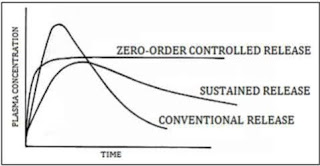Biopharmaceutics math quiZ
- Get link
- X
- Other Apps
A 70-kg volunteer is given an intravenous dose of antibiotic, and serum drug concentrations were determined at 1 hour and 6 hours after administration. The drug concentrations were 4.2 and 0.4 mg/L, respectively. What is the half-life for this drug, assuming first-order elimination kinetics?
a. 1.2 hours
b. 1.5 hours
c. 2.5 hours
d. 4.0 hours
e. 6.2 hours
a. 1.2 hours
b. 1.5 hours
c. 2.5 hours
d. 4.0 hours
e. 6.2 hours
After the administration of a single IV dose (500 mg) of theophylline to a patient, the drug amount-time profile in this patient was described by the following equation:
lnC = lnCo - 0.115 * t where t= time in hours.
What will be the percentage of theophylline left in the body after 10 hr of administration?
A) 32 %
B) 58 %
C) 68 %
D) 50%
E) 90%
lnC = lnCo - 0.115 * t where t= time in hours.
What will be the percentage of theophylline left in the body after 10 hr of administration?
A) 32 %
B) 58 %
C) 68 %
D) 50%
E) 90%
A solution of a drug was freshly prepared at a concentration of 300 mg/mL. After 30 days at 25oC, the drug concentration in the solution was 75mg/mL.
Assuming first-order kinetics, when will the drug decline to one-half of the original concentration?
A.10 days
B.15 days
C.20 days
D.25 days
E.30 days
Assuming first-order kinetics, when will the drug decline to one-half of the original concentration?
A.10 days
B.15 days
C.20 days
D.25 days
E.30 days
A new antibiotic drug was given in a single intravenous bolus of 4 mg/kg to five healthy male adults ranging from 23-38 years (average weight 75 kg). Answer the following using the equation Cp = 78e-0.46t (assume units of μg/mL for Cp and hour for t)
a) How much of the drug is left in the body if after 4 Hours?
b) Assuming the drug is no longer effective when the levels decline to less than 2 μg/mL, when should you administer the next dose?
a) How much of the drug is left in the body if after 4 Hours?
b) Assuming the drug is no longer effective when the levels decline to less than 2 μg/mL, when should you administer the next dose?
A single IV injection containing 500 mg of cefamandole nafate is given to an adult female patient (63 years, 55 kg) for a septicemic infection. The volume of distribution is 0.1L/Kg and the elimination half-life is 0.75 hour. Assuming the drug is eliminated by first-order kinetics, calculate the following:
a) The initial plasma concentration (Cp)?
b) The amount of the drug in the body 4 hours after the dose is given?
c) The time for the drug to decline to 0.5 ug/mL, the minimum inhibitory concentration for streptococci?
a) The initial plasma concentration (Cp)?
b) The amount of the drug in the body 4 hours after the dose is given?
c) The time for the drug to decline to 0.5 ug/mL, the minimum inhibitory concentration for streptococci?
Bioavailability data are used to determine all of the following except:
a. The relationship between drug blood levels and clinical efficacy and toxicity
b. The amount or proportion of drug absorbed from the dosage form
c. The duration of the drug's presence in the biologic fluid or tissue correlated with the patient's response
d. The palatability of a drug in different dosage
e. The rate at which the drug is absorbed
a. The relationship between drug blood levels and clinical efficacy and toxicity
b. The amount or proportion of drug absorbed from the dosage form
c. The duration of the drug's presence in the biologic fluid or tissue correlated with the patient's response
d. The palatability of a drug in different dosage
e. The rate at which the drug is absorbed
For each active ingredient, the amount required to make 30 capsules is
Diphenhydramine HCl (750 mg)
Phenyltoloxamine citrate (900mg)
Acetaminophen (9.75g)
Weight of 1 capsule full of Lactose = 475 mg
Weight of 1 capsule full of Diphenhydramine HCl = 400 mg
Weight of 1 capsule full of Phenyltoloxamine citrate = 375 mg
Weight of 1 capsule full of Acetaminophen = 425 mg
Determining the Amount of Lactose Required for making prescription for one capsule:
Diphenhydramine HCl (750 mg)
Phenyltoloxamine citrate (900mg)
Acetaminophen (9.75g)
Weight of 1 capsule full of Lactose = 475 mg
Weight of 1 capsule full of Diphenhydramine HCl = 400 mg
Weight of 1 capsule full of Phenyltoloxamine citrate = 375 mg
Weight of 1 capsule full of Acetaminophen = 425 mg
Determining the Amount of Lactose Required for making prescription for one capsule:
All of the following may occur during Phase 1 clinical trials of a prospective new drug except:
A.
Testing in human beings for drug safety
B.
Testing in human beings for drug effectiveness
C.
Evaluating side effects associated with increasing doses
D.
Selecting from among different chemical analogs of a lead compound
A.
Testing in human beings for drug safety
B.
Testing in human beings for drug effectiveness
C.
Evaluating side effects associated with increasing doses
D.
Selecting from among different chemical analogs of a lead compound
Which of the following are appropriate compounding practices? Preparation of components into formulation: (Select all that apply).
A.
For the purpose of research or teaching
B.
For chemical analysis and not for sale or dispensing
C.
For a patient as the result of a prescription drug order
D.
For resale by other local pharmacies
E.
In the limited amounts in anticipation of receiving prescription drug order
A.
For the purpose of research or teaching
B.
For chemical analysis and not for sale or dispensing
C.
For a patient as the result of a prescription drug order
D.
For resale by other local pharmacies
E.
In the limited amounts in anticipation of receiving prescription drug order
All of the following statements are true regarding drug metabolism except:
A.
May take place in the liver, kidney, lungs, and gastrointestinal tract
B.
Involves the biochemical transformation of drug substance
C.
Some new drugs have been discovered as metabolites of other processes
D.
Specific and nonspecific enzymes participate in the metabolic process
E.
Metabolites of the administered drug never have pharmacologic activity
A.
May take place in the liver, kidney, lungs, and gastrointestinal tract
B.
Involves the biochemical transformation of drug substance
C.
Some new drugs have been discovered as metabolites of other processes
D.
Specific and nonspecific enzymes participate in the metabolic process
E.
Metabolites of the administered drug never have pharmacologic activity
- Get link
- X
- Other Apps



Comments
Post a Comment
Thanks